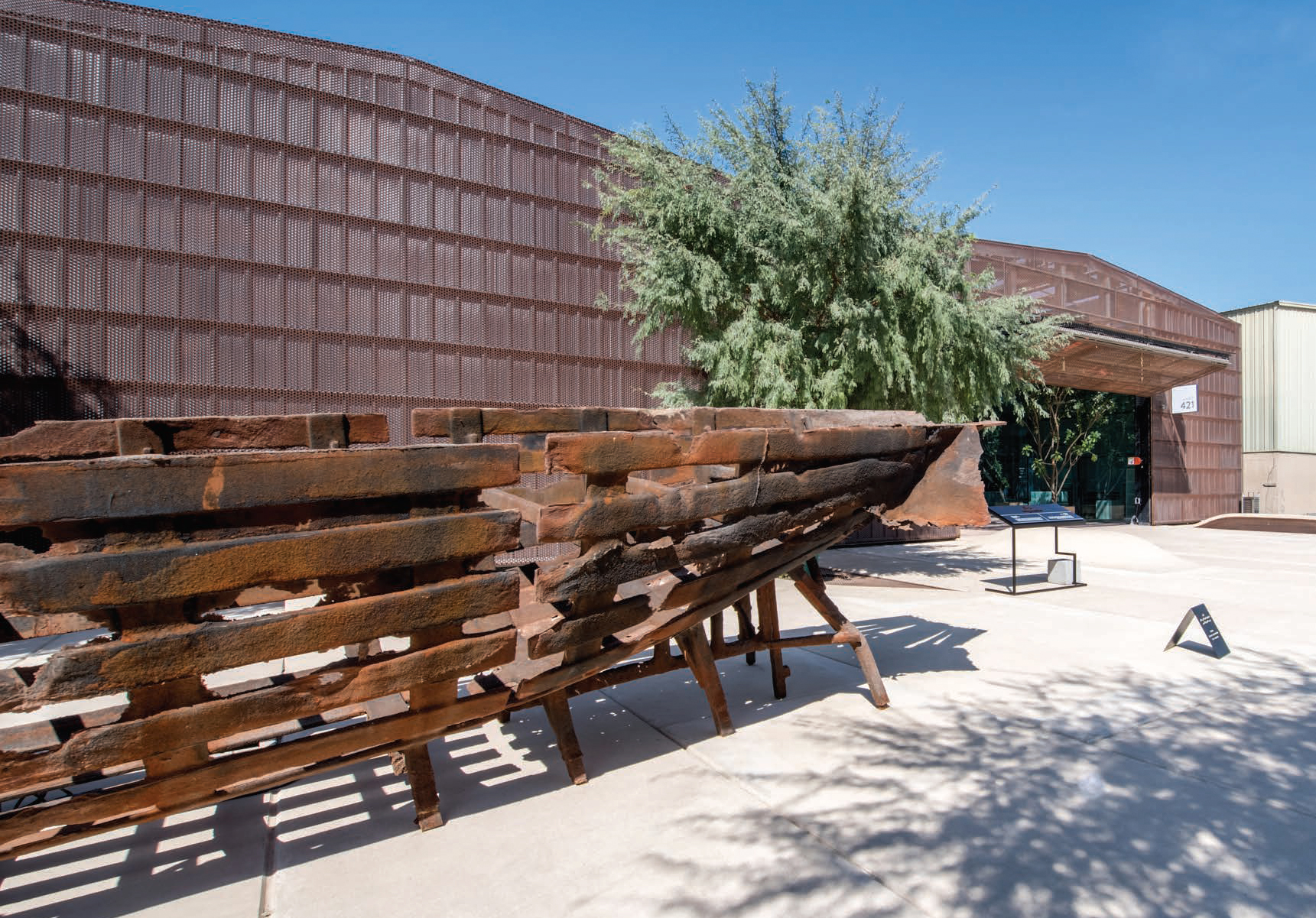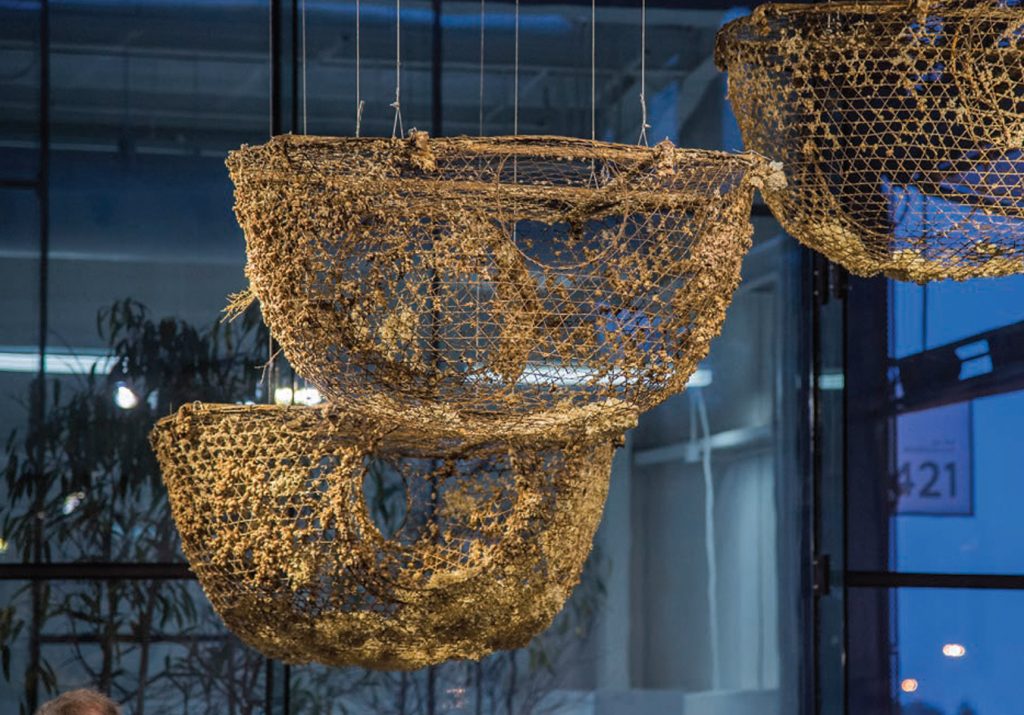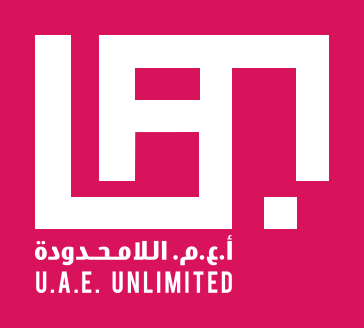Envisioning the present
1st March 2017, Canvas

Just before the opening of UAE Unlimited’s third edition, Bayn: The In-Between, at Warehouse 421 in Abu Dhabi, Nadine Khalil sits down with the curator, Munira Al Sayegh.
By: Nadine Khalil. Canvas.If you go to the old commercial port of Abu Dhabi, in the Mina Zayed area, you’ll notice that all the pastel-coloured industrial warehouses look like replicas except for one: Warehouse 421. Wrapped in perforated Corten steel and with central courtyards, it’s a wonderful hybrid of modernist architecture and regional vernacular. In front of it is a gigantic dhow, also cast in iron, mirroring the earthy orange sunset tones of the warehouse façade. A label indicates that this 18-metre ship comprises seven non-assembled pieces placed together to allow for the spaces in between – rather fitting, since the title of Warehouse 421’s current exhibition is Bayn: The In-Between.
Warehouse 421 is a multidisciplinary cultural space for talks, workshops, screenings and performances that also serves as an art gallery. Inside, it’s all grey concrete and white paint. And near an airy section that highlights the trees that are integrated into the design, Munira Al Sayegh, the surprisingly young curator of the show, is describing the idea behind it. “This theme of the exhibition has been a personal fascination of mine since high school,” Al Sayegh says, going on to explain how she was one of the very few Emiratis to attend an American school in Abu Dhabi. “Our cultural differences always made me interrogate this sense of being a minority within your own culture and ask: where do I stand? And how can I remain relevant to both cultures? The initial idea for the show was transformation, but I don’t think in terms of broad brushstrokes,” she continues, “I was interested in artistic reactions to changes that were anthropological in nature. I was reading about the idea of liminality and rites of passage, and I worked with Shobha on coming up with an Arabic title…”
Shobha Pia Shamdasani is executive director of the satellite arts platform, UAE Unlimited, which was established in 2015 by HH Sheikh Zayed bin Sultan bin Khalifa Al Nahyan. “Surprisingly, here we are in the UAE and barely any exhibitions have been given an Arabic title. Most are generally in English,” Shamdasani adds. UAE Unlimited began the new trend last year, by putting on an exhibition in Sharjah’s Maraya Art Centre that grappled with issues of migration, entitled Al Haraka Baraka. By supporting emerging Emirati artists in an annual exhibition, Shamdasani has made it her mission to empower young talents in the region, and this includes art professionals. After recommendations from the arts community, she discovered Al Sayegh, who studied history of art and archaeology at SOAS in London and interned at the Solomon R. Guggenheim Museum in New York before returning to Abu Dhabi. “When Munira and I first met, we both had the same thought: permanence and roots,” recalls Shamdasani. “However, as Munira discovered, the topic most artists were interested in was that of transformation, so we decided that, if that is what was on their minds, then let that flow into their creativity.”

Asma Al Ahmed. Geo Displacement 2016-7 Wire mesh, projector. Variable dimensions.
“We were also looking at what’s happening here at Saadiyat, which made me think of the hypothetical realm we live in,” Al Sayegh says, “because it’s us looking at the future, with ideas of projects that will come later, like Vision 2020. The only constant in the reality of the Emirates is this continuous change. We have this deep hold of traditions that we aren’t allowed to change but at the same time, we are expected to create the future. And there’s a gap in between our past and future. This exhibition is addressing the present.” A key element of the present is transience, especially in light of the rapidly changing social, cultural and physical topographies of the UAE. In effect, Al Sayegh is documenting this in-between moment in the history of the country. Her investigations led her to the 17th-century Latin roots of the word liminality (limen), which actually means threshold. In her reading, Al Sayegh learned that in his 1909 book Les Rites de Passage, ethnologist Arnold van Gennep broke liminality down into three phases: separation, which allows for reflection; transition, which leads to change; and incorporation, or acceptance. And these levels of estrangement, evolution and integration are manifest in all of the showcased works, both conceptually and tangibly, as exemplified by the ‘imaginary’ tour I’m given by Al Sayegh – imaginary because at the time of going to press, the pieces were yet to be installed.

Talin Hazbar. Accumulation 2016-7. Gargour (traditional Emirati fishing nets).
Other forms of engagement with landscape and memory are the works of two artists grappling with the erosion and gradual disappearance of Ras Al Khaimah’s mountainscapes (Contemporary Archaeology and Geo Displacement by Nasser Alzayani and Asma Al Ahmed, respectively), with projections of stones and an archaeology of casts alluding to their absence. “The boulders from the mountain were used to build skyscrapers,” Al Sayegh explains, “and Asma constructed her mountain of mesh using the material that often covers construction sites. You can walk through her installation; it has empty pockets. Hers is a nostalgic experience while Nasser creates a museum-like documentation of the moment the landscape changes from one thing to another.”
The erasure of landscapes is accompanied by sound and Maytha Al Shamsi depicts ‘a sound shower’ particular to Abu Dhabi in three parts: Bayn Jisrain (Between Two Bridges), The Curator, I am Hear. The viewer/ listener is meant to stand between two speakers, with each emitting sound that’s inspired by its two main bridges: Maqta, the first bridge to connect the island to the mainland in 1967, and the Sheikh Zayed bridge designed by Zaha Hadid in 2010. “It’s a painting of Abu Dhabi through a conversation between the two, like the new generation in conversation with the old,” Al Sayegh explains. Another loop includes both electronic and natural sounds of the city, as signals, gestures and multilingual codes, and a third is an immersive piece of the mind’s chatter and its internal thought process. “This work reads like a muffled purgatory,” she says.

Sara Al Haddad. inhale 2016-7. Tissue paper. All artwork images courtesy of Warehouse 421.
In this show, Al Sayegh is suggesting a middle ground, a kind of threshold between who we were, and who we are now – especially relevant given that, using a completely different aesthetic, Warehouse 421 is also hosting the concurrent exhibition Lest We Forget, which explores traditional modes of Emirati adornment. Perhaps the strongest statement of the show is that the two need not be contradictory, since they both offer narratives and counter-narratives of this condition of flux, the liminal state of being suspended between two things: the past, the beginnings of a nation, and history-in-the-making, a vision of possible futures.
